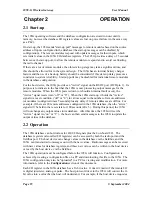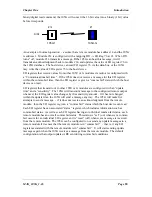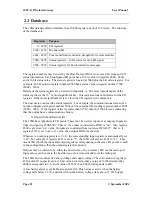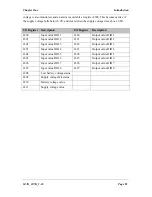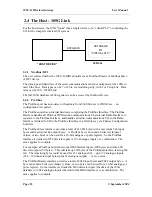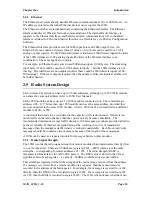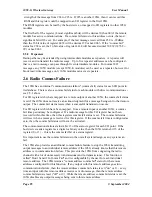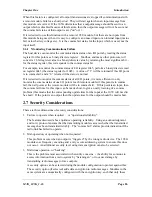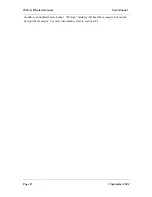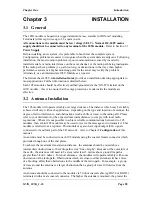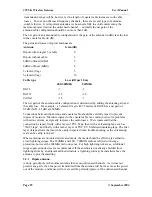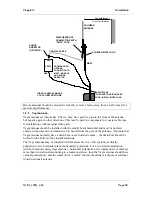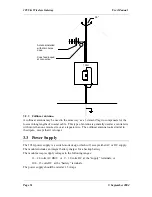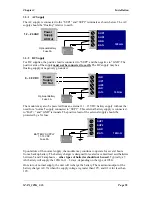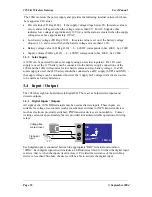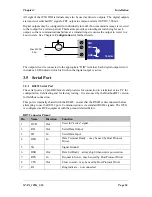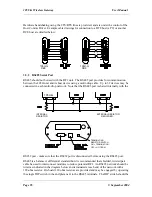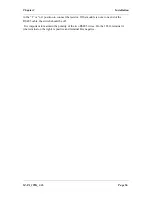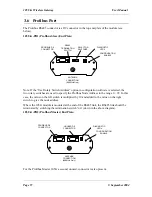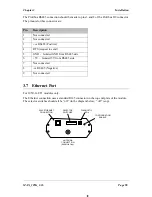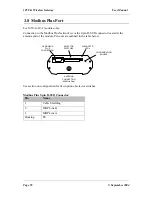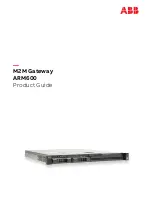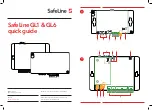
Chapter One
Introduction
MAN_105G_1.16
Page 24
2.4.3
Ethernet
The Ethernet port automatically handles Ethernet communications at 10 or 100 Mbit/sec. An
IP address is entered so that other Ethernet devices can recognize the 105G.
The Ethernet units have internal hardware comprising the Ethernet Interface. The Ethernet
Interface handles all Ethernet Network communications. The internal Radio Interface is
separate to the Ethernet Interface, and handles all radio communications. I/O in the Radio
Interface is linked to I/O in the Ethernet Interface in a flexible way via ESeries Configuration
Software.
The Ethernet Interface provides a total of 2048 input bytes and 2048 output bytes. An
Ethernet byte can contain 8 discrete (binary) values, or two bytes can be used for a 16-bit
analog or pulse register. So the Ethernet Interface is limited to 4300 discrete inputs (the limit
of the 105G database) or 1024 analog inputs (the limit of the Ethernet interface) or a
combination. The same applies for outputs.
For example, an Ethernet host wants to read 500 analog inputs (1000 bytes). The remaining
input bytes (1548) could be used for 12,384 discrete inputs - but the 105G database is not
this big. Provided there are no outputs required, there could be 3800 discrete inputs (4300 –
500 analogs). If there are outputs required, then the number of discrete inputs available will
be further limited.
2.5
Radio System Design
Each wireless I/O system can have up to 95 unit addresses, although up to 255 105K module
can share the same unit address (refer to 105K User Manual).
Each 105U module can have up to 31 x 105S modules connected to it. These modules are
addressed 96 - 127. More than one 105S module can have the same address, provided they
are not connected to the same 105U module - that is, #100 via #16 is identified as a different
module to #100 via #65.
A constraint that needs to be considered is the capacity of the radio channel. If there is too
much traffic on the radio channel, then the system quickly becomes unreliable. The
recommended maximum average traffic density is 100 messages per minute provided all radio
paths are reliable. If there are marginal radio paths, resulting in re-tries of transmitted
messages, then the maximum traffic density is reduced considerably. Each block read/write
messages should be counted as two messages because of the length of these messages.
A 105G can be used as a repeater module for messages between other modules.
2.5.1
Radio Signal Strength
The 105G records the radio signal strength of remote modules that communicate directly (that
is, not via repeaters). There are 95 database registers (4401 – 4495) which store the radio
strengths – corresponding to remote addresses #1 - #95. The radio strength (RSSI) is
measured in dBm (relative to 1mW of RF power). The RSSI value is stored in the 8 least
significant bits of each register - a value of –84 dBm would be stored as decimal 84.
These database registers will hold the strength of the last message received from the address.
If a message is received from a remote module via a repeater, then the measurement is
recorded in the address of the last repeater. For example, if a message is received from #24
directly, then the RSSI will be recorded in register 4424. If a message is received from #24
via #25, then the RSSI is recorded in register 4425. The 105G will not know what the radio










